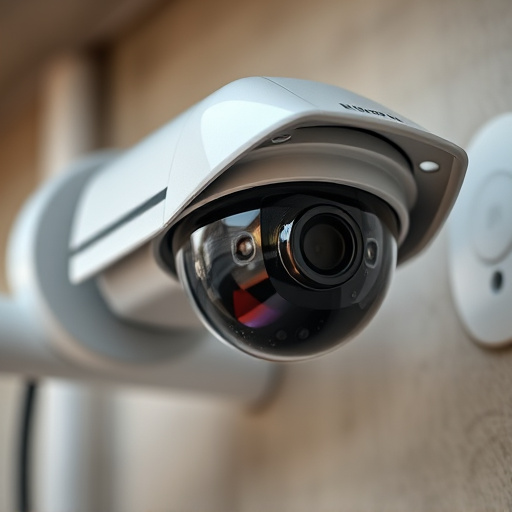The best placement for fake security cameras involves strategically positioning them in high-risk areas like entrances, exits, and valuable asset locations, both on walls or ceilings with visible signs. These decoy cameras should be realistic in appearance and number to effectively deter criminals, while avoiding obvious spots and ensuring clear lines of sight for optimal visibility. This approach enhances physical security, creates an illusion of comprehensive surveillance, and offers a cost-effective solution compared to real cameras.
In today’s digital age, enhancing security measures is paramount. One innovative solution gaining traction is the strategic placement of fake security cameras. This article explores the best placement for fake security cameras, delving into their purpose and the key factors that optimize their effectiveness. We’ll guide you through common mistakes to avoid, and highlight real-world applications showcasing the benefits of strategic fake camera placement.
- Understanding Fake Security Cameras and Their Purpose
- Key Factors to Consider for Optimal Placement
- Common Mistakes to Avoid When Positioning Fake Cameras
- Real-World Applications and Benefits of Strategic Placement
Understanding Fake Security Cameras and Their Purpose
Fake security cameras, also known as dummy or decoy cameras, serve a unique purpose in enhancing physical security. Unlike their functional counterparts, these devices are designed to deter crime and create the illusion of enhanced surveillance. Strategically placed, they can act as powerful visual deterrents, misleading potential intruders and providing a false sense of security. By mimicking real camera locations, they can disrupt criminal activities and serve as valuable components in a comprehensive security strategy.
When considering the best placement for fake security cameras, it’s essential to think like a would-be intruder. High-risk areas such as entrances, exits, and areas with valuable assets should be prioritized. Mounting these cameras on walls or ceilings, near signs indicating their presence, can maximize their psychological impact. Additionally, varying camera positions and orientations can create an unpredictable environment, making it harder for criminals to identify potential weak points.
Key Factors to Consider for Optimal Placement
When determining the best placement for fake security cameras, several key factors come into play. Firstly, consider the area’s inherent vulnerabilities and potential risks. Identify high-value assets or areas that require heightened surveillance, such as entry points, valuable merchandise displays, or secure rooms. Fake cameras strategically placed in these zones can deter crime and create the perception of enhanced security.
Secondly, realness is paramount. Ensure the fake cameras mimic genuine security equipment closely. This includes replicating the look, positioning, and number of cameras needed for a comprehensive coverage. Additionally, consider environmental factors like lighting and visibility to ensure the cameras remain effective throughout the day and night. By addressing these aspects, you can create an authentic deterrent, providing peace of mind and potentially saving valuable resources in true security measures.
Common Mistakes to Avoid When Positioning Fake Cameras
When deploying fake security cameras, it’s crucial to avoid common pitfalls that can render them ineffective. One major mistake is placing them in obvious locations where their purpose as deterrents becomes apparent. Criminals are savvy; they know where to look for signs of genuine surveillance, so hiding these cameras strategically is key to their success. Avoid common spots like directly above doors or windows, or in plain sight on walls or ceilings—these areas are often the first to be checked by potential intruders.
Another error is not considering the lighting and visibility conditions. Fake cameras should be placed where they have clear lines of sight with minimal obstructions. Dark or poorly lit areas won’t capture quality footage. Ensure there’s adequate natural or artificial light for optimal camera visibility. Additionally, avoid placing them too close to objects that could obscure their view, such as bushes, signs, or other structures, as this can limit their effectiveness as a security measure.
Real-World Applications and Benefits of Strategic Placement
In real-world scenarios, strategically placing fake security cameras can significantly enhance physical security and act as a powerful deterrent for potential intruders. Beyond simply simulating surveillance, these decoy devices offer tangible benefits when deployed thoughtfully. By positioning them in areas where genuine cameras might be expected—entrances, exits, dead ends, and high-value asset locations—fake security cameras create an illusion of comprehensive coverage, encouraging would-be criminals to reconsider their actions.
This strategic placement can foster a sense of enhanced security for occupants while providing a cost-effective solution compared to installing numerous real cameras. It’s not just about visual deception; it’s a tactical approach that leverages the psychology of fear and uncertainty to deter criminal activity. When integrated into a broader security strategy, fake security cameras can serve as an important tool in creating a safer environment.
The strategic placement of fake security cameras is a powerful tool to enhance actual security measures. By understanding their purpose and optimal positioning, individuals and businesses can deter crime and create a sense of safety. Avoiding common mistakes and learning from real-world applications, as discussed in this article, will ensure the best placement for fake security cameras, ultimately providing peace of mind and improved security.
